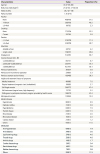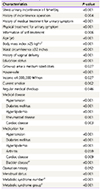1. Abrams P, Cardozo L, Fall M, Griffiths D, Rosier P, Ulmsten U, et al. The standardisation of terminology of lower urinary tract function: report from the Standardisation Sub-committee of the International Continence Society. Neurourol Urodyn. 2002; 21:167–178.

2. Stewart WF, Van Rooyen JB, Cundiff GW, Abrams P, Herzog AR, Corey R, et al. Prevalence and burden of overactive bladder in the United States. World J Urol. 2003; 20:327–336.

3. Irwin DE, Milsom I, Hunskaar S, Reilly K, Kopp Z, Herschorn S, et al. Population-based survey of urinary incontinence, overactive bladder, and other lower urinary tract symptoms in five countries: results of the EPIC study. Eur Urol. 2006; 50:1306–1314.

4. Lugo Salcedo F, Sánchez Borrego R. G.U.I.A.S Group. Assessment of female prevalence of overactive bladder (OAB) in Barcelona using a self-administered screening questionnaire: the Cuestionario de Autoevaluación del Control de la Vejiga (CACV). Int Urogynecol J Pelvic Floor Dysfunct. 2013; 24:1559–1566.

5. Kogan MI, Zachoval R, Ozyurt C, Schafer T, Christensen N. Epidemiology and impact of urinary incontinence, overactive bladder, and other lower urinary tract symptoms: results of the EPIC survey in Russia, Czech Republic, and Turkey. Curr Med Res Opin. 2014; 30:2119–2130.

6. Lee YS, Lee KS, Jung JH, Han DH, Oh SJ, Seo JT, et al. Prevalence of overactive bladder, urinary incontinence, and lower urinary tract symptoms: results of Korean EPIC study. World J Urol. 2011; 29:185–190.

7. Mauseth SA, Skurtveit S, Spigset O. Adherence, persistence and switch rates for anticholinergic drugs used for overactive bladder in women: data from the Norwegian Prescription Database. Acta Obstet Gynecol Scand. 2013; 92:1208–1215.

8. Michel MC, Schneider T, Krege S, Goepel M. Does gender or age affect the efficacy and safety of tolterodine? J Urol. 2002; 168:1027–1031.

9. Richter HE, Burgio KL, Chai TC, Kraus SR, Xu Y, Nyberg L, et al. Predictors of outcomes in the treatment of urge urinary incontinence in women. Int Urogynecol J Pelvic Floor Dysfunct. 2009; 20:489–497.

10. Homma Y, Yoshida M, Seki N, Yokoyama O, Kakizaki H, Gotoh M, et al. Symptom assessment tool for overactive bladder syndrome--overactive bladder symptom score. Urology. 2006; 68:318–323.

11. Jeong SJ, Homma Y, Oh SJ. Korean version of the overactive bladder symptom score questionnaire: translation and linguistic validation. Int Neurourol J. 2011; 15:135–142.

12. Choo MS, Ku JH, Lee JB, Lee DH, Kim JC, Kim HJ, et al. Cross-cultural differences for adapting overactive bladder symptoms: results of an epidemiologic survey in Korea. World J Urol. 2007; 25:505–511.

13. Sang JH, Park HM. Survey on the prevalence of overactive bladder in healthy Korean postmenopausal women. J Korean Soc Menopause. 2012; 18:60–66.

14. Coyne KS, Sexton CC, Bell JA. The prevalence of lower urinary tract symptoms (LUTS) and overactive bladder (OAB) by racial/ethnic group and age: results from OAB-POLL. Neurourol Urodyn. 2013; 32:230–237.

15. Seim A, Hoyo C, Ostbye T, Vatten L. The prevalence and correlates of urinary tract symptoms in Norwegian men: the HUNT study. BJU Int. 2005; 96:88–92.

16. Yoshida M, Miyamae K, Iwashita H, Otani M, Inadome A. Management of detrusor dysfunction in the elderly: changes in acetylcholine and adenosine triphosphate release during aging. Urology. 2004; 63:17–23.

17. Koskimäki J, Hakama M, Huhtala H, Tammela TL. Association of smoking with lower urinary tract symptoms. J Urol. 1998; 159:1580–1582.
18. Tähtinen RM, Auvinen A, Cartwright R, Johnson TM 2nd, Tammela TL, Tikkinen KA. Smoking and bladder symptoms in women. Obstet Gynecol. 2011; 118:643–648.

19. Knuutinen A, Kokkonen N, Risteli J, Vähäkangas K, Kallioinen M, Salo T, et al. Smoking affects collagen synthesis and extracellular matrix turnover in human skin. Br J Dermatol. 2002; 146:588–594.

20. Baron JA, La Vecchia C, Levi F. The antiestrogenic effect of cigarette smoking in women. Am J Obstet Gynecol. 1990; 162:502–514.

21. Chung MS, Chuang YC, Lee JJ, Lee WC, Chancellor MB, Liu RT. Prevalence and associated risk factors of nocturia and subsequent mortality in 1,301 patients with type 2 diabetes. Int Urol Nephrol. 2014; 46:1269–1275.

22. de Boer TA, Slieker-ten Hove MC, Burger CW, Vierhout ME. The prevalence and risk factors of overactive bladder symptoms and its relation to pelvic organ prolapse symptoms in a general female population. Int Urogynecol J Pelvic Floor Dysfunct. 2011; 22:569–575.

23. Al-Shaiji TF, Radomski SB. Relationship between body mass index and overactive bladder in women and correlations with urodynamic evaluation. Int Neurourol J. 2012; 16:126–131.

24. Ohgaki K, Horiuchi K, Kondo Y. Association between metabolic syndrome and male overactive bladder in a Japanese population based on three different sets of criteria for metabolic syndrome and the overactive bladder symptom score. Urology. 2012; 79:1372–1378.

25. Kupelian V, McVary KT, Kaplan SA, Hall SA, Link CL, Aiyer LP, et al. Association of lower urinary tract symptoms and the metabolic syndrome: results from the Boston area community health survey. J Urol. 2013; 189:S107–S114.

26. Uzun H, Yilmaz A, Kemik A, Zorba OU, Kalkan M. Association of insulin resistance with overactive bladder in female patients. Int Neurourol J. 2012; 16:181–186.

27. Uzun H, Zorba OU. Metabolic syndrome in female patients with overactive bladder. Urology. 2012; 79:72–75.

28. Lee WC, Chien CT, Yu HJ, Lee SW. Bladder dysfunction in rats with metabolic syndrome induced by long-term fructose feeding. J Urol. 2008; 179:2470–2476.

29. Tong YC, Cheng JT. Alteration of M2, 3-muscarinic receptor protein and mRNA expression in the bladder of the fructose fed obese rat. J Urol. 2007; 178:1537–1542.








 PDF
PDF ePub
ePub Citation
Citation Print
Print





 XML Download
XML Download